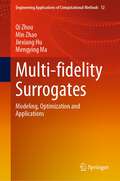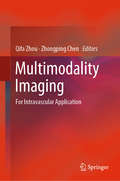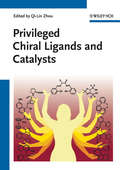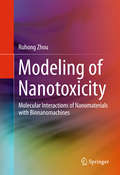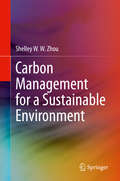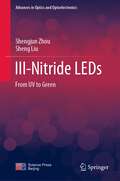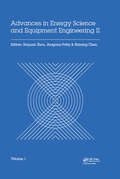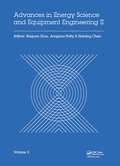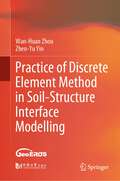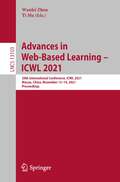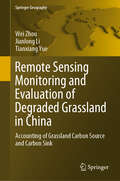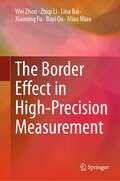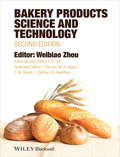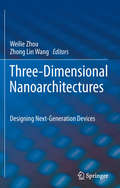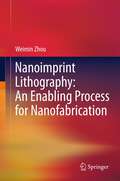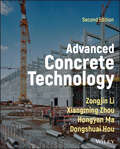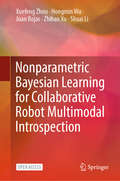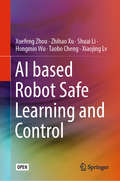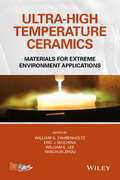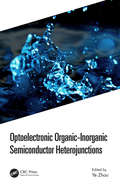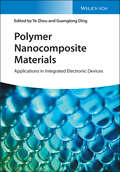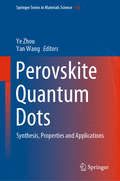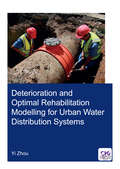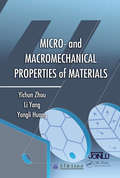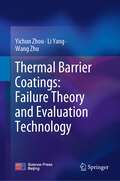- Table View
- List View
Multi-fidelity Surrogates: Modeling, Optimization and Applications (Engineering Applications of Computational Methods #12)
by Qi Zhou Min Zhao Jiexiang Hu Mengying MaThis book investigates two types of static multi-fidelity surrogates modeling approaches, sequential multi-fidelity surrogates modeling approaches, the multi-fidelity surrogates-assisted efficient global optimization, reliability analysis, robust design optimization, and evolutionary optimization. Multi-fidelity surrogates have attracted a significant amount of attention in simulation-based design and optimization in recent years. Some real-life engineering design problems, such as prediction of angular distortion in the laser welding, optimization design of micro-aerial vehicle fuselage, and optimization design of metamaterial vibration isolator, are also provided to illustrate the ability and merits of multi-fidelity surrogates in support of engineering design. Specifically, lots of illustrative examples are adopted throughout the book to help explain the approaches in a more “hands-on” manner. This book is a useful reference for postgraduates and researchers of mechanical engineering, as well as engineers of enterprises in related fields.
Multimodality Imaging: For Intravascular Application
by Qifa Zhou Zhongping ChenThis book provides a state-of-the-art overview of the combined use of imaging modalities to obtain important functional and morphological information on intravascular disease and enhance disease detection. It discusses the integration of intravascular ultrasound (IVUS, intravascular optical coherence tomography (OCT), intravascular photoacoustic imaging (IVPA) and acoustic radiation force optical coherence elastography (ARF-OCE), and introduces the integration of multimodality imaging systems, such as IR and florescence. It includes the latest research advances and numerous imaging photos to offer readers insights into current intravascular applications. It is a valuable resource for students, scientists and physicians wanting to gain a deeper understanding of multimodality imaging tools.
Privileged Chiral Ligands and Catalysts
by Qi-Lin ZhouCatalytic asymmetric synthesis has been one of the most active research areas in chemistry (Nobel Prize in 2001). The development of efficient chiral catalysts plays a crucial role in asymmetric catalysis. Although many chiral ligands/catalysts have been developed in the past decades, the most efficient catalysts are derived from a few core structures, called "privileged chiral catalysts". This ultimate "must have" and long awaited reference for every chemist working in the field of asymmetric catalysis starts with the core structure of the catalysts, explaining why a certain ligand or catalyst is so successful. It describes in detail the history, the basic structural characteristics, and the applications of these "privileged catalysts". This novel presentation provides readers with a much deeper insight into the topic and makes it a must-have for organic chemists, catalytic chemists, chemists working with/on organometallics, chemists in industry, and libraries. From the contents: * BINAP * Bisphosphacycles - From DuPhos and BPE to a Diverse Set of Broadly Applied Ligands * Josiphos Ligands: From Discovery to Technical Applications * Chiral Spiro Ligands * Chiral Bisoxazoline Ligands * PHOX Ligands * Chiral Salen Complexes * BINOL * TADDOLate Ligands * Cinchona Alkaloids * Proline Derivatives
Modeling of Nanotoxicity
by Ruhong ZhouThis book captures the perspectives of nanotoxicity through the transformation of theoretical molecular biology. The chapters are organized by various types of nanomaterials and illustrate how molecular (classical mechanics) and atomic (quantum mechanics) modeling approaches can be applied to change our understanding of many important aspects of this critical nanotoxicity issue. Together these chapters provide a comprehensive overview of the fundamentals of nanotoxicity modeling and its implications in nanomedicine development. This is an ideal book for academic and industry professionals as well as graduate students in nanoscience and nanotechnology, nanomedicine development, and computational science.
Carbon Management for a Sustainable Environment
by Shelley W. ZhouThis textbook presents students with a systematic approach for the quantification and management of greenhouse gas emissions (GHG) and provides best practices for optimal carbon management and quantification. The book begins with an overview of climate change basics and goes on to discuss carbon footprint measurements, carbon management concepts, and concludes by presenting carbon reduction solutions with applications for green buildings, smart transportation, waste management, and carbon trading and offsetting. The author provides practical examples and carbon management models that support innovative reduction solutions and presents a roadmap for the implementation and development of carbon management strategies, making it a useful resource for both upper undergraduate and graduate students as well as practitioners seeking a comprehensive framework to conduct carbon management.
III-Nitride LEDs: From UV to Green (Advances in Optics and Optoelectronics)
by Shengjun Zhou Sheng LiuThis book highlights state-of-the-art in III-nitrides-based light-emitting diodes (LEDs). Motivated by the application prospects in lighting, high-resolution display, and health & medicine, the book systematically introduces the physical fundamentals, epitaxial growth, and device fabrications of III-nitride-based LEDs. Important topics including the structures of chips, device reliability and measurements and the advances in mini and micro LEDs are also discussed. The book is completed with a decade of research experience of the author’s team in the design and fabrication of III-nitrides-based LEDs, presenting the novel achievements in the stress control of the large mismatch heterostructures, defect formation and inhibition mechanism of the heteroepitaxial growth, LED epitaxial technologies, and the fabrication of high-efficient flip-chip LEDs. The book comprises of a valuable reference source for researchers and professionals engaged in the research and development of III-nitrides-based LEDs.
Advances in Energy Science and Equipment Engineering II Volume 1: Proceedings of the 2nd International Conference on Energy Equipment Science and Engineering (ICEESE 2016), November 12-14, 2016, Guangzhou, China
by Shiquan Zhou Aragona Patty Shiming ChenThe 2016 2nd International Conference on Energy Equipment Science and Engineering (ICEESE 2016) will be held on November 12-14, 2016 in Guangzhou, China. ICEESE 2016 is to bring together innovative academics and industrial experts in the field of energy equipment science and engineering to a common forum. The primary goal of the conference is to promote research and developmental activities in energy equipment science and engineering and another goal is to promote scientific information interchange between researchers, developers, engineers, students, and practitioners working all around the world. The conference will be held every year to make it an ideal platform for people to share views and experiences in energy equipment science and engineering and related areas.
Advances in Energy Science and Equipment Engineering II Volume 2: Proceedings of the 2nd International Conference on Energy Equipment Science and Engineering (ICEESE 2016), November 12-14, 2016, Guangzhou, China
by Shiquan Zhou Aragona Patty Shiming ChenThe 2016 2nd International Conference on Energy Equipment Science and Engineering (ICEESE 2016) was held on November 12-14, 2016 in Guangzhou, China. ICEESE 2016 brought together innovative academics and industrial experts in the field of energy equipment science and engineering to a common forum. The primary goal of the conference is to promote research and developmental activities in energy equipment science and engineering and another goal is to promote scientific information interchange between researchers, developers, engineers, students, and practitioners working all around the world. The conference will be held every year to make it an ideal platform for people to share views and experiences in energy equipment science and engineering and related areas. This second volume of the two-volume set of proceedings covers the field of Structural and Materials Sciences, and Computer Simulation & Computer and Electrical Engineering.
Practice of Discrete Element Method in Soil-Structure Interface Modelling
by Wan-Huan Zhou Zhen-Yu YinThis book is related to a parametric study of the soil–structural interface shearing behavior based on the numerical simulations of interface shear test with DEM, which is conducted from the role of soil properties, particle properties and structural properties. To aid readers in easily understanding the generation, implementation of models and controlling modes, for each part, the relevant code is provided in the text, and the whole source code of model is given in Appendix to share with readers for practice. The book is intended for graduate-level teaching and research in soil mechanics and geotechnical engineering, as well as in other related engineering specialties. This book is also of use to industry practitioners due to the inclusion of real-world applications, opening the door to advanced courses on modeling within the industrial engineering and operations research fields.
Advances in Web-Based Learning – ICWL 2021: 20th International Conference, ICWL 2021, Macau, China, November 13–14, 2021, Proceedings (Lecture Notes in Computer Science #13103)
by Wanlei Zhou Yi MuThis book constitutes the proceedings of the 20th International Conference on Advances in Web-Based Learning, ICWL 2021, which was held in Macau, China, in November 2021. The papers included in this volume deal with multiple topics, from algorithms to systems and applications and are organized in 3 tracks: Online learning methodologies, trust, and analysis; Online learning environment with tools; Online learning privacy issues and special tools.
Remote Sensing Monitoring and Evaluation of Degraded Grassland in China: Accounting of Grassland Carbon Source and Carbon Sink (Springer Geography)
by Wei Zhou Jianlong Li Tianxiang YueThis book focuses on grassland ecosystem evaluation including vegetation coverage, net primary productivity, carbon sink accounting, and grassland degradation evaluation based on mutual data resource, ecosystem model simulation, remote sensing monitoring and driving mechanism exploration. It aims to provide a guide seeking to understand the overall situation of grassland in China in the context of global climate change and build a scenario for the driving force quantitative evaluation. It will be an essential reference to the terrestrial ecosystem carbon cycle and degraded grassland ecological restoration engineer implementation. Chapters are carefully developed to cover (1) situation of grassland in China; (2) spatial-temporal of grassland coverage in China;(3) net primary productivity evaluation; (4) carbon sink/source accounting and its carbon-hydrology effect;(5) grassland landscape pattern; (6) grassland degradation evaluation based on remote sensing;(7) Grassland degradation restoration and constructing green ecological protective screen. The new scenario and driving mechanism evaluation model make this book a valuable read for researcher of land ecosystem carbon cycle, ecosytem degradation remote sensing evaluation as well as organizations engaged in eco-restoration practices.
The Border Effect in High-Precision Measurement
by Wei Zhou Zhiqi Li Lina Bai Xiaoning Fu Bayi Qu Miao MiaoThis book introduces various kinds of high-precision measurements, including the measurements of time and space, digital activity, border sensors and other physical quantities. Further, it demonstrates how to eliminate the quantitative errors believed to be the main problem in measurements using the border effect. In metrology technology, detection resolution is crucial to improving measurement precision in devices and instruments, and since the resolution is limited, a fuzzy area is usually found during detection. As such the book presents numerous experimental findings showing that the measurement precision can be improved by two or three orders of magnitude compared to traditional methods by achieving stability of resolution and more accurately detecting the border of the fuzzy area.
Bakery Products Science and Technology
by Weibiao Zhou Y. H. HuiBaking is a process that has been practiced for centuries, and bakery products range in complexity from the simple ingredients of a plain pastry to the numerous components of a cake. While currently there are many books available aimed at food service operators, culinary art instruction and consumers, relatively few professional publications exist that cover the science and technology of baking. In this book, professionals from industry, government and academia contribute their perspectives on the state of industrial baking today. The second edition of this successful and comprehensive overview of bakery science is revised and expanded, featuring chapters on various bread and non-bread products from around the world, as well as nutrition and packaging, processing, quality control, global bread varieties and other popular bakery products. The book is structured to follow the baking process, from the basics, flour and other ingredients, to mixing, proofing and baking. Blending the technical aspects of baking with the latest scientific research, Bakery Products Science and Technology, Second Edition has all the finest ingredients to serve the most demanding appetites of food science professionals, researchers, and students.
Three-Dimensional Nanoarchitectures
by Weilie Zhou Zhong Lin WangDevices built from three-dimensional nanoarchitectures offer a number of advantages over those based on thin-film technology, such as larger surface area to enhance the sensitivity of sensors, to collect more sunlight to improve the efficiency of solar cells, and to supply higher density emitters for increased resolution in flat panel displays. Three-dimensional nanoscale assembly has already been used to generate many prototypes of devices and sensors, including piezoelectric nanogenerators based on ZnO nanowire arrays, photovoltaic devices based on silicon nanowire array p-n junctions, and highly sensitive gas sensors based on metal oxide nanowire arrays among others. Three-Dimensional Nanoarchitectures: Designing Next-Generation Devices describes state-of-the-art synthesis, integration, and design strategies used to create three-dimensional nanoarchitectures for functional nanodevice applications. With a focus on synthesis and fabrication methods for three-dimensional nanostructure assembly and construction, coverage includes resonators, nanophotonics, sensors, supercapacitors, solar cells, and more. This book is an essential reference for a broad audience of researchers in materials science, chemistry, physics, and electrical engineering who want the latest information on synthesis routes and assembly methods. Schematics of device integration and mechanisms as well as plots of measurement data are included.
Nanoimprint Lithography: An Enabling Process for Nanofabrication
by Weimin ZhouNanoimprint Lithography: An enabling process for nanofabrication presents a comprehensive description of nanotechnology that is one of the most promising low-cost, high-throughput technologies for manufacturing nanostructures, and an emerging lithography candidates for 22, 16 and 11 nm nodes. It provides the exciting, multidisciplinary field, offering a wide range of topics covering: principles, process, material and application. This book would be of specific interest for researchers and graduate students in the field of nanoscience, nanotechnology and nanofabrication, material, physical, chemical, electric engineering and biology. Dr. Weimin Zhou is an associate professor at Shanghai Nanotechnology Promotion Center, China.
Advanced Concrete Technology
by Xiangming Zhou Zongjin Li Hongyan Ma Dongshuai HouAdvanced Concrete Technology A thorough grounding in the science of concrete combined with the latest developments in the rapidly evolving field of concrete technology In the newly revised second edition of Advanced Concrete Technology, a distinguished team of academics and engineers delivers a state-of-the-art exploration of modern and advanced concrete technologies developed during the last decade. The book combines the essential concepts and theory of concrete with practical examples of material design, composition, processing, characterization, properties, and performance. The authors explain, in detail, the hardware and software of concrete, and offer readers discussions of the most recent advances in concrete technology, including, but not limited to, concrete recycling, nanotechnology, microstructural simulation, additive manufacturing, and non-destructive testing methods. This newest edition of Advanced Concrete Technology provides a sustained emphasis on sustainable and novel technologies, like new binders, 3D printing, and other advanced materials and techniques. Readers will also find: A thorough introduction to concrete, including its definition and its historical evolution as a material used in engineering and construction In-depth explorations of the materials for making concrete and the properties of fresh concrete Comprehensive discussions of the material structure of concrete, hardened concrete, and advanced cementitious composites Fulsome treatments of concrete fracture mechanics, non-destructive testing in concrete engineering, and future trends in concrete Perfect for undergraduate and graduate students studying civil or materials engineering—especially those taking classes in the properties of concrete or concrete technologies—as well as engineers in the concrete industry. Advanced Concrete Technology, 2nd Edition will also earn a place in the libraries of civil and materials engineers working in the industry.
Nonparametric Bayesian Learning for Collaborative Robot Multimodal Introspection
by Xuefeng Zhou Hongmin Wu Juan Rojas Zhihao Xu Shuai LiThis open access book focuses on robot introspection, which has a direct impact on physical human–robot interaction and long-term autonomy, and which can benefit from autonomous anomaly monitoring and diagnosis, as well as anomaly recovery strategies. In robotics, the ability to reason, solve their own anomalies and proactively enrich owned knowledge is a direct way to improve autonomous behaviors. To this end, the authors start by considering the underlying pattern of multimodal observation during robot manipulation, which can effectively be modeled as a parametric hidden Markov model (HMM). They then adopt a nonparametric Bayesian approach in defining a prior using the hierarchical Dirichlet process (HDP) on the standard HMM parameters, known as the Hierarchical Dirichlet Process Hidden Markov Model (HDP-HMM). The HDP-HMM can examine an HMM with an unbounded number of possible states and allows flexibility in the complexity of the learned model and the development of reliable and scalable variational inference methods.This book is a valuable reference resource for researchers and designers in the field of robot learning and multimodal perception, as well as for senior undergraduate and graduate university students.
AI based Robot Safe Learning and Control
by Xuefeng Zhou Zhihao Xu Shuai Li Hongmin Wu Taobo Cheng Xiaojing LvThis open access book mainly focuses on the safe control of robot manipulators. The control schemes are mainly developed based on dynamic neural network, which is an important theoretical branch of deep reinforcement learning. In order to enhance the safety performance of robot systems, the control strategies include adaptive tracking control for robots with model uncertainties, compliance control in uncertain environments, obstacle avoidance in dynamic workspace. The idea for this book on solving safe control of robot arms was conceived during the industrial applications and the research discussion in the laboratory. Most of the materials in this book are derived from the authors’ papers published in journals, such as IEEE Transactions on Industrial Electronics, neurocomputing, etc. This book can be used as a reference book for researcher and designer of the robotic systems and AI based controllers, and can also be used as a reference book for senior undergraduate and graduate students in colleges and universities.
Ultra-High Temperature Ceramics: Materials for Extreme Environment Applications
by Yanchun Zhou William G. Fahrenholtz William E. Lee Eric J. WuchinaThe first comprehensive book to focus on ultra-high temperature ceramic materials in more than 20 years Ultra-High Temperature Ceramics are a family of compounds that display an unusual combination of properties, including extremely high melting temperatures (>3000°C), high hardness, and good chemical stability and strength at high temperatures. Typical UHTC materials are the carbides, nitrides, and borides of transition metals, but the Group IV compounds (Ti, Zr, Hf) plus TaC are generally considered to be the main focus of research due to the superior melting temperatures and stable high-melting temperature oxide that forms in situ. Rather than focusing on the latest scientific results, Ultra-High Temperature Ceramics: Materials for Extreme Environment Applications broadly and critically combines the historical aspects and the state-of-the-art on the processing, densification, properties, and performance of boride and carbide ceramics. In reviewing the historic studies and recent progress in the field, Ultra-High Temperature Ceramics: Materials for Extreme Environment Applications provides: Original reviews of research conducted in the 1960s and 70s Content on electronic structure, synthesis, powder processing, densification, property measurement, and characterization of boride and carbide ceramics. Emphasis on materials for hypersonic aerospace applications such as wing leading edges and propulsion components for vehicles traveling faster than Mach 5 Information on materials used in the extreme environments associated with high speed cutting tools and nuclear power generation Contributions are based on presentations by leading research groups at the conference "Ultra-High Temperature Ceramics: Materials for Extreme Environment Applications II" held May 13-19, 2012 in Hernstein, Austria. Bringing together disparate researchers from academia, government, and industry in a singular forum, the meeting cultivated didactic discussions and efforts between bench researchers, designers and engineers in assaying results in a broader context and moving the technology forward toward near- and long-term use. This book is useful for furnace manufacturers, aerospace manufacturers that may be pursuing hypersonic technology, researchers studying any aspect of boride and carbide ceramics, and practitioners of high-temperature structural ceramics.
Optoelectronic Organic-Inorganic Semiconductor Heterojunctions
by Ye ZhouOptoelectronic Organic-Inorganic Semiconductor Heterojunctions summarizes advances in the development of organic-inorganic semiconductor heterojunctions, points out challenges and possible solutions for material/device design, and evaluates prospects for commercial applications. Introduces the concept and basic mechanism of semiconductor heterojunctions Describes a series of organic-inorganic semiconductor heterojunctions with desirable electrical and optical properties for optoelectronic devices Discusses typical devices such as solar cells, photo-detectors, and optoelectronic memories Outlines the materials and device challenges as well as possible strategies to promote the commercial translation of semiconductor heterojunctions-based optoelectronic devices Aimed at graduate students and researchers working in solid-state materials and electronics, this book offers a comprehensive yet accessible view of the state of the art and future directions.
Polymer Nanocomposite Materials: Applications in Integrated Electronic Devices
by Ye Zhou Guanglong DingDiscover an authoritative overview of zero-, one-, and two-dimensional polymer nanomaterials Polymer Nanocomposite Materials: Applications in Integrated Electronic Devices delivers an original and insightful treatment of polymer nanocomposite applications in energy, information, and biotechnology. The book systematically reviews the preparation and characterization of polymer nanocomposites from zero-, one-, and two-dimensional nanomaterials. The two distinguished editors have selected resources that thoroughly explore the applications of polymer nanocomposites in energy, information, and biotechnology devices like sensors, solar cells, data storage devices, and artificial synapses. Academic researchers and professional developers alike will enjoy one of the first books on the subject of this environmentally friendly and versatile new technology. Polymer Nanocomposite Materials discusses challenges associated with the devices and materials, possible strategies for future directions of the technology, and the possible commercial applications of electronic devices built on these materials. Readers will also benefit from the inclusion of: A thorough introduction to the fabrication of conductive polymer composites and their applications in sensors An exploration of biodegradable polymer nanocomposites for electronics and polymer nanocomposites for photodetectors Practical discussions of polymer nanocomposites for pressure sensors and the application of polymer nanocomposites in energy storage devices An examination of functional polymer nanocomposites for triboelectric nanogenerators and resistive switching memory Perfect for materials scientists and polymer chemists, Polymer Nanocomposite Materials: Applications in Integrated Electronic Devices will also earn a place in the libraries of sensor developers, electrical engineers, and other professionals working in the sensor industry seeking an authoritative one-stop reference for nanocomposite applications.
Perovskite Quantum Dots: Synthesis, Properties and Applications (Springer Series in Materials Science #303)
by Ye Zhou Yan WangThis book addresses perovskite quantum dots, discussing their unique properties, synthesis, and applications in nanoscale optoelectronic and photonic devices, as well as the challenges and possible solutions in the context of device design and the prospects for commercial applications. It particularly focuses on the luminescent properties, which differ from those of the corresponding quantum dots materials, such as multicolor emission, fluorescence narrowing, and tunable and switchable emissions from doped nanostructures. The book first describes the characterization and fabrication of perovskite quantum dots. It also provides detailed methods for analyzing the electrical and optical properties, and demonstrates promising applications of perovskite quantum dots. Furthermore, it presents a series of optoelectronic and photonic devices based on functional perovskite quantum dots, and explains the incorporation of perovskite quantum dots in semiconductor devices and their effect of the performance. It also explores the challenges related to optoelectronic devices, as well as possible strategies to promote their commercialization. As such, this book is a valuable resource for graduate students and researchers in the field of solid-state materials and electronics wanting to gain a better understanding of the characteristics of quantum dots, and the fundamental optoelectronic properties and operation mechanisms of the latest perovskite quantum dot-based devices.
Deterioration and Optimal Rehabilitation Modelling for Urban Water Distribution Systems (IHE Delft PhD Thesis Series)
by Yi ZhouPipe failures in water distribution systems can have a serious impact and hence it’s important to maintain the condition and integrity of the distribution system. This book presents a whole-life cost optimisation model for the rehabilitation of water distribution systems. It combines a pipe breakage number prediction model with a pipe criticality assessment model, which enables the creation of a well-constructed and more tightly constrained optimisation model. The pipe breakage number prediction model combines information on the physical characteristics of the pipes with historical information on breakage and failure rates. A weighted multiple nonlinear regression analysis is applied to describe the condition of different pipe groups. The criticality assessment model combines a pipe’s condition with its hydraulic significance through a modified TOPSIS. This model enables the optimisation to focus its efforts on those important pipes. The whole life cost optimal rehabilitation model is a multiple-objective and multiple-stage model, which provides a suite of rehabilitation decisions that minimise the whole life cost while maximising its long-term performance. The optimisation model is solved using a modified NSGA-II. The utility of the developed models is that it allows decision makers to prioritize their rehabilitation strategy in a proactive and cost-effective manner.
Micro- and Macromechanical Properties of Materials (ISSN)
by Yichun Zhou Li Yang Yongli HuangThis is an English translation of a Chinese textbook that has been designated a national planned university textbook, the highest award given to scientific textbooks in China. The book provides a complete overview of mechanical properties and fracture mechanics in materials science, mechanics, and physics. It details the macro- and micro-mechanical properties of metal structural materials, nonmetal structural materials, and various functional materials. It also discusses the macro and micro failure mechanism under different loadings and contains research results on thin film mechanics, smart material mechanics, and more.
Thermal Barrier Coatings: Failure Theory and Evaluation Technology
by Yichun Zhou Li Yang Wang ZhuThis book highlights the failure theories and evaluation techniques of thermal barrier coatings, covering the thermal-mechanical–chemical coupling theories, performance and damage characterization techniques, and related evaluations. Thermal barrier coatings are the key thermal protection materials for high-temperature components in advanced aeroengines. Coating spallation is a major technical bottleneck faced by researchers. The extremely complex microstructure, diverse service environments, and failure behaviors bring challenges to the spallation analysis in terms of the selective use of mechanical theories, experimental methods, and testing platforms. In the book, the authors provide a systematic summary of the latest research and technological advances and present their insights and findings in the past couple of decades. This book is not only suitable for researchers and engineers in thermal barrier coatings and related fields but also a good reference for upper-undergraduate and postgraduate students of materials science and mechanics majors.
